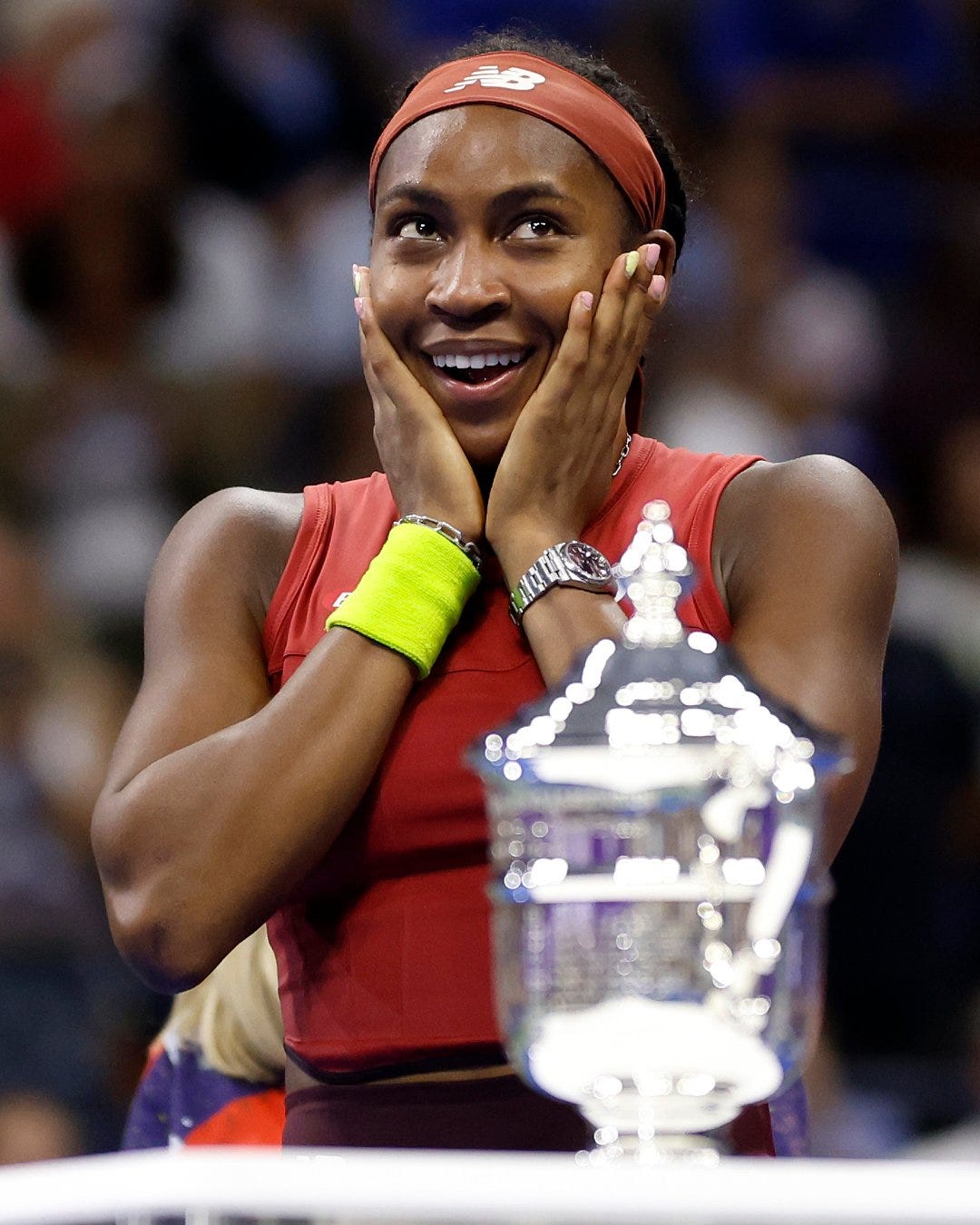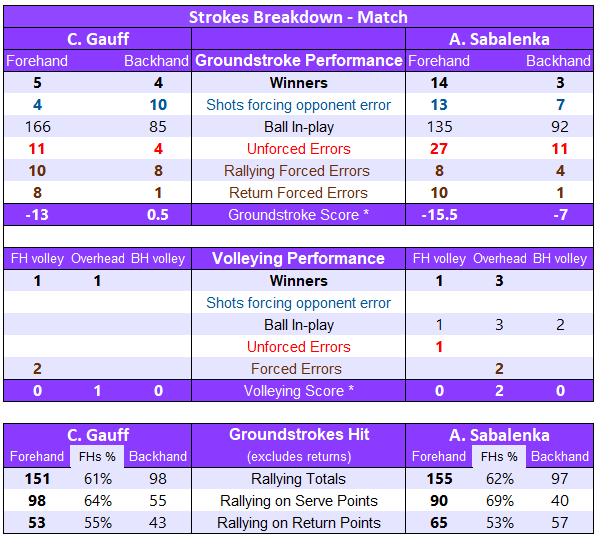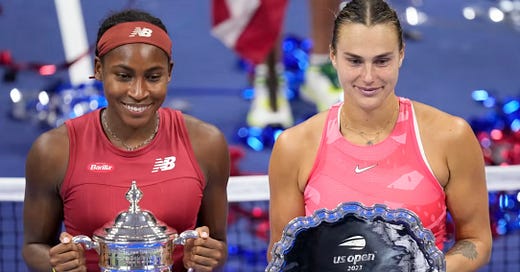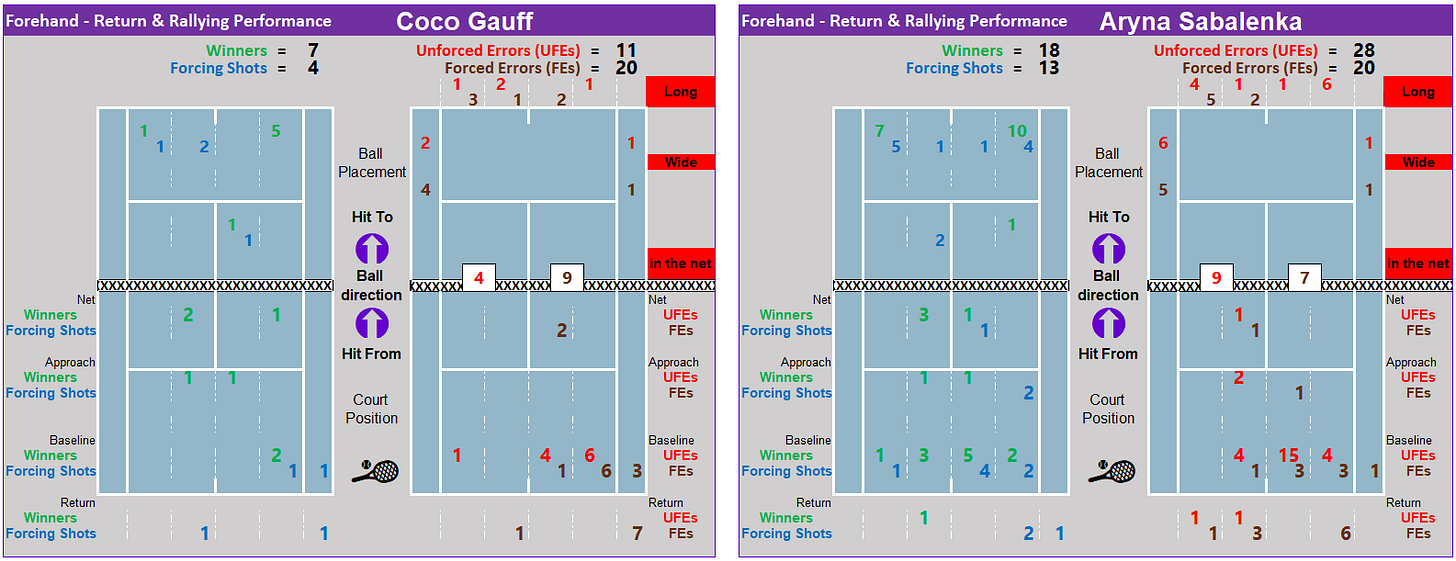A delighted raucous crowd erupted as Coco Gauff closed the match with a backhand winner down the line. She had just become Grand Slam champion as a teenager, validating (or overcoming) the tremendous expectations that accompanied her for at least half a decade.
Victory was extra-special for Gauff as it happened at the U.S. Open, where she went as a kid to watch Serena and Venus Williams play. It happened at the Stadium where she dreamt her future.

Gauff´s rise to Major champion status emerged from the 60’s:
61% Groundstrokes hit as forehands by Gauff
Sabalenka’s gameplan was to relentlessly go after Gauff’s forehand, her suggested weaker side. With much of the match played from the Deuce court, both players ended up hitting over 60% of groundstrokes as forehands (61% for Gauff, 62% for Sabalenka). But contrary to Sabalenka’s expectations, Gauff’s forehand got better as the match progressed while the errors began flowing from the racquet of Sabalenka.
64% Points won by Gauff off Sabalenka’s rallying errors
With Sabalenka intent on playing her usual aggressive tennis, Gauff focused on court coverage and used lightning speed to rescue sure winners and keep points alive.
Sabalenka was on-target early, rushing Gauff and blasting her way through the opening set. But then Gauff adapted. She withstood Sabalenka’s power and got back shot after shot. By the final set, Gauff was in the zone while Sabalenka was exhausted and racking up errors, many of them borne of frustration with Gauff’s defense. Ultimately, 53 out of 83 points won by Gauff (=64%) came from errors by Sabalenka after a rally had developed.
62% Sabalenka’s win rate on net approaches
Another chapter in the “Defense vs Offense” storyline. Sabalenka won 13 of 21 net approaching points, corresponding to a 62% win-percentage. While that is an acceptable number, given some of the short balls Sabalenka had, it would have been higher if not for Gauff’s tremendous ability to keep hanging in points and force Sabalenka to hit one more ball (and eventually miss here and there).
60% Break points saved by Gauff
Gauff saved 6 of 10 break points. The most crucial saves came in the first game of the second set. Gauff double-faulted twice to fall behind 15-40. She was staring at a possible set-and-break deficit to an opponent that had outplayed her in the first set. But instead of getting her decisive confidence-booster, Sabalenka played a terrible four-point sequence. Gauff saved the first break point with an unreturned serve. The second break point was erased as Sabalenka steered wide a routine slice backhand that was hit rather purposelessly. From Deuce, Sabalenka tried to go big on a couple of 2nd serve returns but missed. The serve hold brought a different body language to Gauff as she switched sides. The crowd sensed it and got even louder, charging her up. This was the moment the energy shifted and the match turned.
67% Serve games won by Gauff after facing break point, over the last 2 sets
There were plenty of clutch moments from Gauff during the last two sets. On her serve, she managed to rescue two of the three games in which she had to face break point. The only time Gauff surrendered her serve was when she had a 4-1, double-break lead in set 3. And she reacted immediately by breaking back in the following game.
Gauff was even more impressive on her return games. Over the last 2 sets, she broke serve on all four games in which she reached break points. Every time, Gauff consolidated the break by holding serve in the following game.
60 Gauff’s matches in Majors
The US Open final was career Grand Slam match number 60 since 15-year-old Gauff debuted as the youngest qualifier in Wimbledon history. Her big breakthrough has now arrived after sustained growth through a poised, mature and professional path.
Gauff may be the best athlete in women’s tennis, but her most impressive quality is a willingness to learn from each setback. Her flustering first-round loss at this year’s Wimbledon was no exception and it propelled her to bolster her coaching team by joining Brad Gilbert to Pere Riba. It took them just six weeks to produce the “Summer of Coco”. With 18 wins and a single loss, Gauff won three of the four tournaments she entered, each victory increasing in size. Until it got real big, in the Big Apple.

Coco Gauff eletrified the city and the country. Her surge to victory after losing the first set showed an incredibly strong attitude. Even more so as Gauff had lost her only previous Grand Slam final at Roland Garros last year.
“My life was going to end. That French Open loss was a heartbreak for me. That makes this moment even sweeter than I could imagine.
Right now I'm just feeling happiness and a very, very small bit of relief, because honestly, at this point, I was doing it for myself and not for other people.”
— Coco Gauff
Certainly one of the most special moments of the year came when Gauff shared tears of joy as she hugged Mom and Dad and those sitting inside her box.
Match Story
Sabalenka dominated the inaugural set in virtually every facet. She shot more winners (6 vs 2) and forced more rallying errors (8 vs 4). Her serve also gave Gauff plenty of problems as 1 in every 4 serves was unreturned (26% of unreturned serves for Sabalenka).

Both players committed 10 unforced errors (UFEs) in the first set, but there was a dramatic change in the second set. Sabalenka saw her UFEs shoot to 16 while Gauff significantly reduced her UFEs to 3. Gauff also cut on her return errors, improving to 88% of returns into play. It largely contrasted with Sabalenka’s struggles, as the 2-seed could only return into play 69% of serves.
In addition to return errors, Sabalenka also made a combined 10 errors on “serve+1” and “return+1” shots. It decreased average rally length to 3.77 shots per point in set 2.
With so many errors early in rallies during set 2, did Sabalenka try to play a bit more conservatively in set 3? Or was her tired body not allowing her to rip the ball as usual? By now Gauff was confidently playing error-free tennis.
It all added up that points got longer in the deciding set:
Average rally length increased to 5.71
Unreturned serves (rally length =1) reduced to 11%
Percentage of long rallies (9+ shots) by set:
Set 1- 9%
Set 2- 9%
Set 3- 27%
Gauff made sure Sabalenka's legs kept burning, right from the start of each game. The final set featured 8 games; 6 games began with double-digit rallies.
Rally length of the first point of each game in set 3:
11 / 12 / 12 / 10 / 3 / 10 / 5 /11
Remarkably, of the 6 times a game started with a double-digit rally, the following point ended on a Sabalenka error in 5 occasions.
The final dagger came on a high-intensity exchange as Sabalenka served at 2-4 15/15. Sabalenka hit 6 forehands but could not finish the point and the longest rally of the match (20 shots) eventually ended on a Sabalenka backhand error. It was a symbolic end to the match as Sabalenka would not win another point. A few minutes later, Gauff held to love for the first time in the match to confirm her crowning moment.
A few closing words about Sabalenka. She leaves New York with the consolation prize of becoming the world #1 player. The 25-year-old won her first Major at the Australian Open and she reached the semi-finals of all four Grand Slam events. She was not very far from playing in all four finals. At Roland-Garros, Sabalenka held match point in the semi-final against Karolina Muchova. At Wimbledon, she led Ons Jabeur by a set and 4-2.
“That ranking milestone is why I'm not super depressed right now. I'm definitely going to be. I'm definitely going for a drink tonight. If I'm allowed to say that.”
— Coco Gauff
Coco Gauff (WTA #6, seed 6) vs Aryna Sabalenka (WTA #2, seed 2)
US Open Final - Match Data
Strokes Breakdown

Both players finished with better backhand groundstrokes scores.
Gauff’s forehand may have been less active in ending points but it was 2.5 points better than Sabalenka’s forehand. Sabalenka hit 14 forehand groundstroke winners but she also made 27 forehand groundstroke UFEs.
Gauff’s backhand was solid. It produced 4 winners and 10 forcing shots while leaking just 4 UFEs and 9 forced errors. It was the only groundstroke that ended with a positive score.
Winners and Errors
Sabalenka ended with 10 more winners and 24 more UFEs.
The differential between winners and UFEs shows that Gauff closed the match with a 14-point advantage (-4 vs -18).
The differential between winners and all errors also favours Gauff by 10 points (-33 vs -43).
Given Sabalenka’s gameplan, it was very significant that Gauff had the edge on forehand side.
6-point edge for Gauff in differential between FH winners and FH UFEs
6-point edge for Gauff in differential between FH winners and FH errors
Gauff’s consistency in the final set was outstanding:
Forehand: 1 UFE / 1 FE
Backhand: 1 UFE / 3 FEs
Rallying performance maps
Gauff struck 8 of 11 winners to the backhand corner of Sabalenka.
A significant amount of Sabalenka’s UFEs were hit from the middle of the baseline.
1st Serves
On the Deuce side, Gauff avoided serves down the T.
“Body FH” serves gave problems to Sabalenka as she missed 6 of 7 returns.
Despite these unreturned serves, Gauff won 13 of 30 Deuce side points (43%).
On the AD side, Gauff targeted FH returns. It was a good strategy as she won 20 of 23 points (87%).
Sabalenka favoured serves targeting the Gauff FH. This was particularly evident on the Deuce side, as Sabalenka served wide on more than 80% of points.
Gauff missed 4 FH returns on wide Deuce side serves.
2nd Serves
Gauff opted for central, jamming 2nd serves on the Deuce side. Sabalenka played a few run-around FH returns.
On the AD side, Gauff mixed body serves with down the T deliveries.
Sabalenka continued to serve wide on the Deuce side (89% of serves).
Gauff missed another 3 FH returns on wide Deuce side serves.
On the AD side, Sabalenka varied between corners with a few body serves in-between.
All of Sabalenka’s 6 DFs came on AD side points.
Serve & Return
Gauff had the higher 1st serve percentage (66% vs 52%). She won 52% of 2nd serve points.
Sabalenka won 65% of 1st serve points. Gauff was just a few points below, at 62%.
Sabalenka missed 14 returns, 5 more than Gauff.
Sabalenka missed 9 returns in set 2, while Gauff was connecting on only 50% of 1st serves.
Strategy
Gauff had the better baseline performance (50% vs 44%).
Sabalenka attacked the net almost twice more than Gauff (21 vs 11).
Gauff had the better win rate on net approaches (73% vs 62%).
Rally Length
Average rally length for the match was 4.43 shots per point.
Longest rally lasted 20 shots and was played at 2-4 15/15 in the deciding set. Gauff won it and she would also win all points played after it.
Points won by Rally Length
Gauff forged her advantage in short rallies, finishing with an 8-point advantage.
She also had a slim 1-point edge on medium length rallies while there was a tie on long rallies.
Points won breakdown
This final section gives a last, broader look at the match by presenting how each player won points. Points are listed according to their frequency (highest to lowest) and are named in relation to the last touch on the ball. For simplicity, groundstrokes hit from the 5th shot onwards are grouped together.
Breakdown by side (FHs or BHs)

Breakdown by error type (UFEs or FEs)

Thumbnail photo credit: US Open Twitter.
To find out more about the stats published here, please visit the following post.
Even though they follow the same criteria used on all major tennis events, they are not official WTA or ITF stats. They are collected through our own rigorous video analysis.














